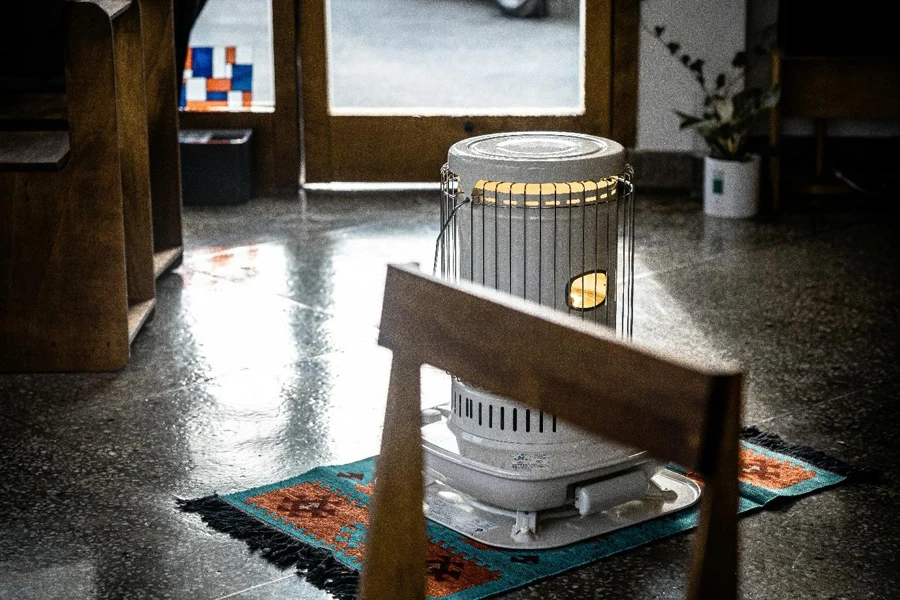As outdoor spaces become essential extensions of homes and commercial venues, patio heaters are gaining recognition as vital solutions for year-round comfort. The demand is driven by homeowners and business operators seeking efficient, reliable heating options to maintain inviting environments, even in colder seasons. Staying current with market trends is crucial for professionals selecting the best heaters, as innovations in energy efficiency, design, and safety are reshaping options across the industry. This guide provides an in-depth look into the patio heater market, heater types, and key factors to consider, equipping buyers with insights to make informed choices. By understanding these elements, decision-makers can enhance outdoor spaces with solutions that meet functional and aesthetic needs.
Table of Contents
● The patio heater market at a glance
● Exploring the types of patio heaters and their standout features
● Key factors to consider when choosing a patio heater
● Conclusion
The patio heater market at a glance

Rising demand and market growth
The patio heater market is witnessing robust growth, with a projected increase of $998.1 million from 2023 to 2028, driven by the rising appeal of outdoor living across residential and commercial spaces, according to Technavio. This market expansion reflects a Compound Annual Growth Rate (CAGR) of 8.8%, as businesses and homeowners seek efficient heating solutions to keep outdoor areas comfortable throughout colder months. Outdoor dining and event spaces have fueled this growth, particularly in regions like North America, where patio heaters are essential to year-round outdoor experiences.
Market segmentation and major players
The patio heater market spans commercial and residential sectors, with products primarily segmented by fuel types, such as gas, electric, and solid fuel. Gas heaters remain popular in larger commercial spaces due to their high output and flexibility. At the same time, electric models are favored for residential and semi-enclosed areas due to their low maintenance and eco-friendly attributes. Key players include AEI Corp., AZ Patio Heaters, and Bromic Group, who lead with product diversity and innovation. Companies focusing on high-quality, efficient products capitalize on the increased demand for user-friendly, safe, and visually appealing models to cater to various business and residential needs.
Key trends driving demand
As the market grows, trends shift towards premiumization and eco-friendly innovations, with businesses prioritizing sustainability and energy efficiency. Patio Fever highlights that integrating infrared technology and smart temperature controls is increasingly common, making heaters more efficient and adaptable to different user preferences. Expanding e-commerce platforms has also boosted accessibility, making it easier for consumers and businesses to explore and purchase a wide range of patio heaters online. Enhanced safety features, such as tip-over switches and protective grills, reflect the industry’s response to consumer demands for secure and dependable heating solutions, further accelerating market adoption.
Exploring the types of patio heaters and their standout features

High-output gas heaters for expansive spaces
Gas heaters are known for their significant heat output, often measured in British Thermal Units (BTUs), with commercial-grade models reaching up to 40,000 BTUs or more. Propane-fueled mushroom heaters typically use 20-pound propane tanks, offering around 10 hours of continuous use before needing a refill. For permanent installations, natural gas heaters connect directly to a gas line, eliminating the need for tank replacements and offering consistent energy flow. Many gas heaters include safety features like thermocouple sensors that automatically cut off gas flow if the pilot light goes out, enhancing safety in commercial setups.
Efficient and eco-friendly electric heaters
Electric heaters are valued for their low emissions and versatility, often rated in watts to measure power usage and output. Standard residential models typically range from 1,500 to 3,000 watts, while more robust commercial models reach up to 6,000 watts, sufficient for smaller enclosed spaces. These heaters use either quartz or ceramic heating elements to provide targeted warmth and often come with digital temperature controls, allowing for precise heat settings and energy management. Many electric models integrate overheat protection and smart home compatibility, enabling remote control for convenient operation in enclosed or semi-enclosed environments.
Cozy ambiance with solid fuel heaters
Solid fuel heaters like wood-burning fire pits offer warmth and an inviting glow. These heaters are typically crafted with steel or cast iron frames to withstand high temperatures, and fire pits can reach upwards of 1,000 degrees Fahrenheit at their core. The radiant heat emitted is effective for localized warming but requires careful monitoring, including regular ash removal and refueling. Unlike other heaters, these solid-fuel models require clearances around open flames. They can be enhanced with adjustable air vents to control burn rate and heat output, making them more manageable for private gatherings.
Shortwave infrared heaters for exposed environments

Shortwave infrared heaters deliver instant heat using quartz elements capable of reaching 1,500 degrees Fahrenheit almost immediately. They work best in exposed areas, as shortwave radiation is minimally affected by wind, providing directed warmth without heating the air. These heaters typically come in 1,500 to 3,000-watt models and are designed for short-term, high-output needs, such as entryways or open patios. Their ruby-colored glow can enhance visibility in dark settings, though they may not suit all decor preferences. Advanced models include adjustable intensity settings, allowing users to modify the heat output for various needs.
Long-lasting comfort from mediumwave infrared heaters
Mediumwave infrared heaters are built with carbon filament bulbs, providing a gentle yet sustained heat output suitable for long-term operation. They operate at around 700 to 900 degrees Fahrenheit, offering a softer heat that is less intense than shortwave. Often used in sheltered outdoor areas, these heaters can cover mid-sized spaces effectively and are available with timer and dimmer controls for customizable warmth. Low-glare technology favors these models for semi-enclosed patios or dining areas where consistent, comfortable warmth is necessary without the intrusive glow.
Longwave infrared heaters for spacious, sheltered spaces
Longwave infrared heaters, utilizing ceramic heating elements, emit a deep, comfortable warmth that people and objects absorb rather than the surrounding air. These heaters warm up more gradually, often requiring 10 to 15 minutes to reach optimal temperatures, but offer the benefit of long-lasting warmth retention. Built for low-light settings, they are ideal for large, sheltered areas with a desired subtle, unobtrusive warmth. Longwave heaters are highly energy-efficient, often consuming lower wattage while providing a sustainable heat source over extended hours.
Space-saving overhead heaters for permanent setups
Overhead patio heaters are designed for wall or ceiling mounts and are often constructed with stainless steel or aluminum casings to withstand outdoor elements. These models are available in gas and electric options and are permanently affixed to maximize space and minimize trip hazards. Overhead heaters typically use reflector plates to direct heat downward, covering an area efficiently with fewer units. They are ideal for commercial settings with high foot traffic and limited space, as they stay out of reach and include tip-over and tilt safety features for secure operation.
Versatile and mobile freestanding heaters
Freestanding patio heaters offer maximum flexibility, with many models built on wheeled bases for easy transport across open spaces. Standard propane-fueled freestanding models can emit up to 40,000 BTUs, covering areas up to 20 feet in diameter. Built with sturdy steel frames and weighted bases, these heaters are designed to remain stable in open environments, though they require periodic tank changes for propane models. Many include piezoelectric ignition systems for reliable starting and flame adjustments, making them ideal for diverse commercial applications.
Compact tabletop heaters for close-proximity warmth
Tabletop heaters, available in propane and electric varieties, are designed for localized heating in dining or lounge areas. Propane models typically include a small cylinder compartment, allowing for several hours of use, while electric models generally lower wattage, around 500 to 1,500 watts. These heaters provide a radiant heat zone that is effective within a close range, making them ideal for personal warmth in small gatherings. Many models come with stainless steel or powder-coated finishes, making them durable against spills or minor impacts in high-use areas.
Key factors to consider when choosing a patio heater

Heating capacity and space coverage
When choosing a patio heater, heating capacity is critical for ensuring efficient warmth without excess energy costs. Capacity is measured in BTUs for gas heaters and watts for electric models, with larger, open spaces requiring higher outputs. Gas heaters can reach up to 40,000 BTUs, covering expansive outdoor areas up to 20 feet in diameter. Electric models generally range from 1,500 to 6,000 watts, with higher wattages suitable for larger enclosed or semi-enclosed spaces. Assessing the space’s size, shape, and exposure allows buyers to select models that provide adequate heat coverage without incurring unnecessary operational costs.
Safety features and maintenance
Safety is paramount, particularly in commercial settings, where tip-over shutoff mechanisms and protective grills are essential for minimizing accidents. Tip-over shutoffs automatically turn off the heater if displaced, reducing fire risks in high-traffic areas. For gas models, thermocouple sensors prevent gas leaks by cutting fuel flow if the pilot light extinguishes unexpectedly. Maintenance varies by fuel type: gas models require regular tank checks and ventilation maintenance, while electric models need periodic wiring and heating element inspections. For solid fuel heaters, frequent ash removal and cleaning help maintain efficiency and reduce emissions.
Fuel source availability and environmental considerations
Fuel availability and environmental impact should weigh heavily in the selection process. Electric heaters have the advantage of lower emissions, particularly in enclosed or semi-enclosed spaces, and can be paired with renewable energy sources for a more sustainable option. Propane and natural gas heaters offer higher heat outputs but require accessible fuel sources and regular refills for propane models. The cost of electricity versus gas should also be considered, with gas often providing higher BTU output per dollar, especially beneficial for large, open areas. Eco-conscious buyers may opt for infrared electric heaters, which focus heat directly on objects and people rather than the surrounding air, thus reducing wasted energy.
Aesthetic integration and installation requirements
Patio heaters come in various designs that allow seamless integration into outdoor aesthetics, whether rustic or modern. Overhead heaters mount directly to ceilings or walls, saving floor space and providing discrete heating that complements decor. Freestanding models are more visible and available in sleek stainless steel or matte finishes that enhance design appeal. Electric models are generally more straightforward for installations and can even be recessed in ceiling setups, while gas heaters may require permanent gas line connections for stability. Choosing a heater that matches the space’s functional and visual needs is key to maximizing utility and ambiance in any setting.
Conclusion

Selecting the right patio heater is essential for creating comfortable and efficient outdoor spaces that can be enjoyed year-round. With options varying in fuel type, heat output, and installation style, a well-chosen heater meets both the functional demands and aesthetic preferences of any setting. Prioritizing safety, operational efficiency, and environmental impact ensures that each space remains inviting and cost-effective. A carefully selected patio heater transforms outdoor areas, enhancing ambiance and usability even in colder months.




